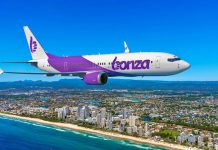Getting around Latin America is set to become easier over the next two decades as a growing middle class ensures that air travel doubles.
Plane maker Airbus is predicting the regions middle class will grow from $350 million people to 520 million by 2037.
And as that happens, more and more Latin Americans will be saying hola! (or ola!) to air travel.
The European aerospace giant says passenger traffic in the region has already doubled since 2002 and it is forecasting that trips per capita will increase from 0.4 in 2017 to almost 0.9 in 2037.
There is also a changing in the mix of traffic with intra-regional travel growing faster in 2017 than the historic market leader, domestic traffic.
Airbus says less than half of the region’s top 20 cities are connected by one daily flight creating a great potential for the region’s airlines to build intra-regional traffic”.
The aviation “megacities” in Latin America — Panama City, Bogota, Buenos Aires, Lima, Mexico City, Santiago and Sao Paulo — are expected to be joined by Mexico’s Cancun and Rio de Janeiro.
READ: Latam launches major international expansion.
The manufacturer defines megacities as those with more than 10,000 long-haul passengers daily.
In terms of aircraft, the Airbus Global Market Forecast predicts the Latin America and Caribbean region will need 2,720 new passenger and freighter aircraft valued at $US349 billion to meet the rising demand.
This is almost double the existing fleet of 1420 aircraft and breaks this down into 2,420 small and 300 medium, large and extra-large aircraft.
Of these, 940 will be for replacement of older-generation aircraft, 1,780 will be due to growth, and 480 are expected to remain in service. The result will be a fleet of 3200 aircraft by 2037.
“We continue to see growth in the region’s air transport sector, despite some economic challenges,’’ Airbus Latin America and Caribbean president Arturo Barreira said at an airline forum.
“With two of the world’s top 13 traffic flows expected to involve Latin America, and traffic expected to double, we are very optimistic that the region will continue to be resilient.
“Also, with intra- and inter-continental demand rising, Latin American carriers will be in a very strong position to increase their footprint in the global long-haul market segment.”
Separately, Airbus announced Tuesday that Europe’s easyJet had converted purchase rights for 17 A320neos to firm orders.
The manufacturer said this took the budget carrier’s combined order for the NEO to 147, including 30 A321neos, and meant easyJet has ordered 468 A320 Family aircraft to date.
“This repeat order cements easyJet’s position as the largest European operator of our leading A320 family,” said Christian Scherer, Airbus chief commercial officer.
The aircraft are configured with 186 seats in a single class configuration and powered by Leap CFM engines.
























